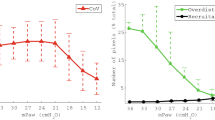Abstract
Objective
We have investigated the role that improvement in arterial oxygenation has, consequent on positive end-expiratory pressure (PEEP), in the reduction of cardiac index (CI) determined by applying PEEP.
Design
2×2 factorial trial.
Setting
Department of intensive care medicine at a university hospital.
Patients
13 patients on mechanical ventilation for acute lung injury.
Interventions
Four experimental conditions, each one characterized by one level of PEEP and one level of PaO2:
Measurements and results
Hemodynamic and gas exchange data were collected for each experimental condition. CI showed a 13% decline from LOLP (7.0±1.71/min per m2) to HOHP (6.1±1.3l/min per m2). Both the direct effect of PEEP on the CI (LOLP+HOLP vs LOHP+ HOHP,p<0.01) and the indirect effect related to the improvement in oxygenation (LOLP+HOLP vs HOLP+HOHP,p<0.01) contributed to the reduction in Cl.Conclusion: In evaluating Cl changes induced by PEEP we should take into account the indirect effect of arterial oxygenation upon CI. This should be considered, at least in part, as a physiological adjustment rather than as impaired cardiovascular performance.
Similar content being viewed by others
References
Marini JJ, Wheeler AP (1989) Positive end expiratory pressure. In: Critical care medicine—the essential. Williams & Wilkins, Baltimore, pp 78–84
Dhainaut J, Devoux J, Monsallier J, Brunet F, Villemant D, Huyghebaert M (1986) Mechanisms of decreased left ventricular preload during continuous positive pressure ventilation in ARDS. Chest 90:74–80
Jardin F, Farcot JC, Boisante L, Curien N, Margairaz A, Bourdarias JP (1981). Influence of positive end expiratory pressure on left ventricular performance. N Engl J Med 304:387–392
Robotham JL, Lixfeld W, Holland L, MacGregor D, Bromberger-Bornea B, Permutt S, Rabson JL (1980) The effects of positive end expiratory pressure on right and left ventricular performance. Am Rev Respir Dis 121:677–683
Dorinsky P, Whitcomb M (1983) The effect of PEEP and cardiac output. Chest 84:210–216
Heistad D, Abboud F (1980) Circulatory adjustment to hypoxia. Circulation 61:463–470
Phillips B, McConnell J, Smith M (1988) The effects of hypoxemia on cardiac output. A dose response curve. Chest 93:471–475
Smith E, Crowell J (1967) Influence of hypoxia on mean circulatory pressure and cardiac output. Am J Physiol 212:1067–1069
Vatner SF, Rutherford JD (1978) Control of the myocardial contractile state by carotid chemo- and baroreceptor and pulmonary inflation reflexes in conscious dogs. J Clin Invest 61:1593–1597
Voren A (1992) Hemodynamic monitoring: arterial and pulmonary artery catheter. In: Civetta JM, Taylor RR, Kirby RW (eds) Critical care. Lippincott, Philadelphia, pp 255–270
Snedecor G, Cochran W (1980) Factorial experiments. In: Statistical methods, 7th edn.. Iowa State University Press, AMES, USA, pp 298–330
Dantzker D, Lynch J, Weg J (1980) Depression of cardiac output is a mechanism of shunt reduction in the therapy of acute respiratory failure. Chest 77:636–642
Bredle D (1989) Circulatory compensation as a response to hypoxia. In: Reinhart K, Eyrich K (eds) Clinical aspects of O2 transport and tissue oxygenation. Springer, Berlin Heidelberg New York, pp 53–63
Sykes M, Adams W, Finley W, McCormick P, Economides A (1970) The effects of variations in end-expiratory inflation pressure on cardiorespiratory function in normo- hypo- and hypervolemic dogs. Br J Anaesth 42:669–677
Bindslev L, Hedenstierna G, Santesson J, Gottlieb I Carvallhas A (1981) Ventilation-perfusion distribution during inhalation anaesthesia: effects of spontaneous breathing, mechanical ventilation and positive end-expiratory pressure. Acta Anaesthesiol Scand 25:360–371
Author information
Authors and Affiliations
Rights and permissions
About this article
Cite this article
Borelli, M., Fumagalli, R., Bernasconi, F. et al. Relief of hypoxemia contributes to a reduction in cardiac index related to the use of positive end-expiratory pressure. Intensive Care Med 22, 382–386 (1996). https://doi.org/10.1007/BF01712152
Received:
Accepted:
Issue Date:
DOI: https://doi.org/10.1007/BF01712152




